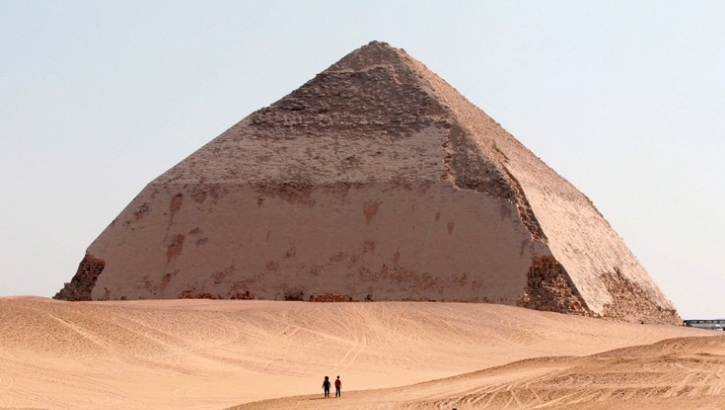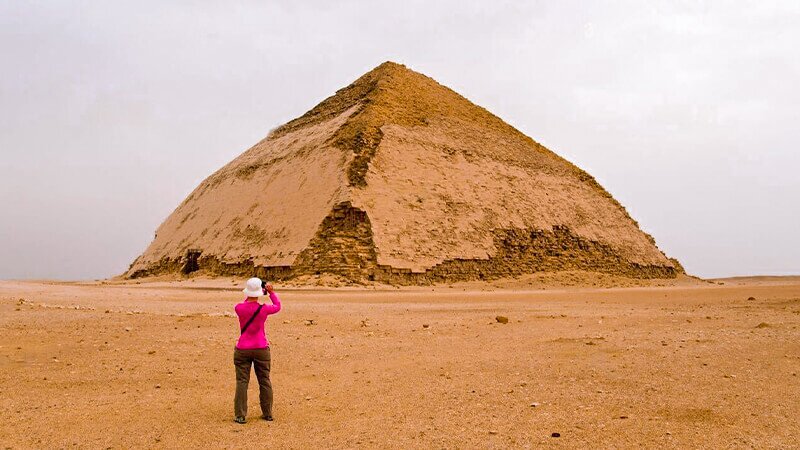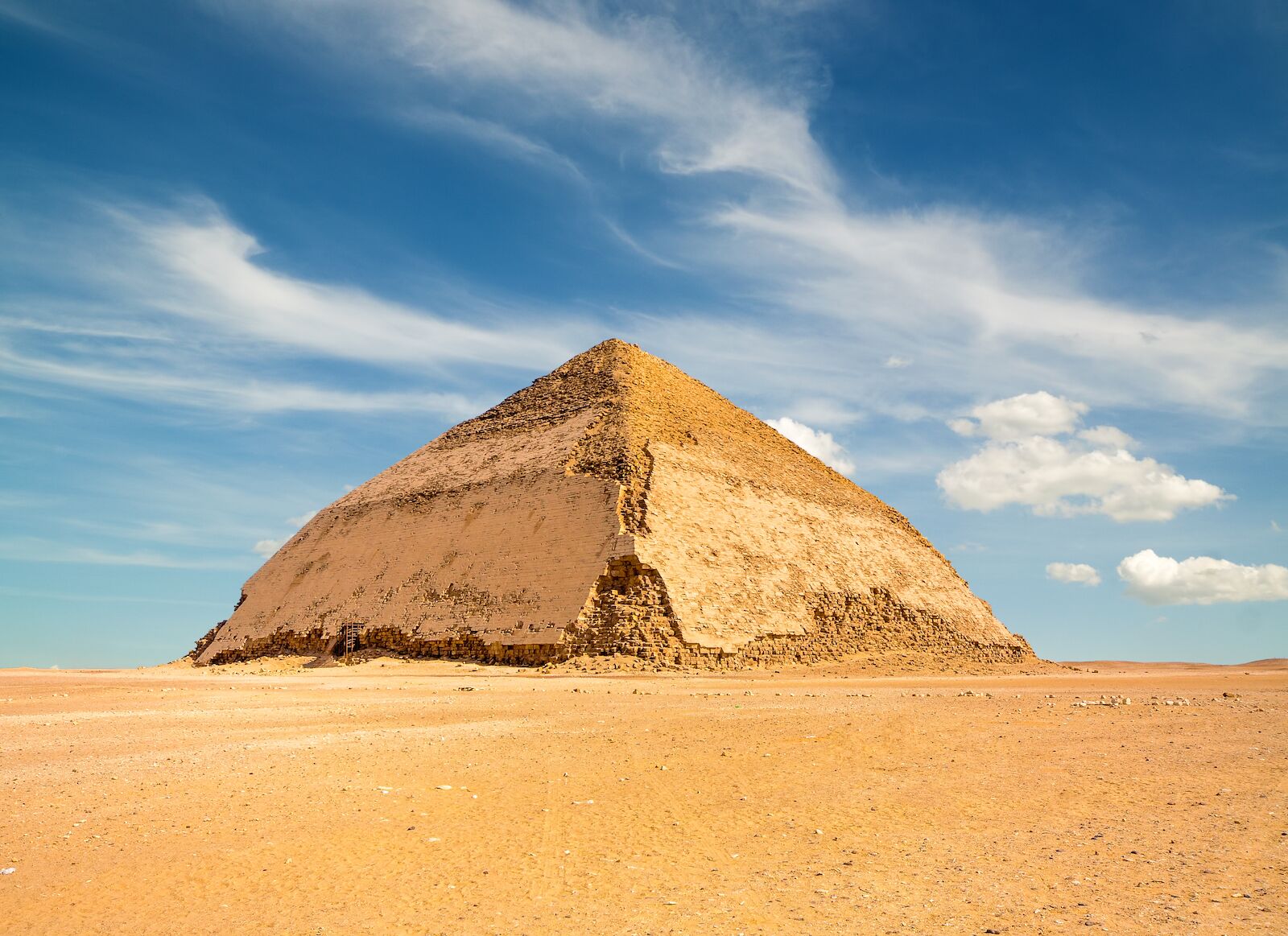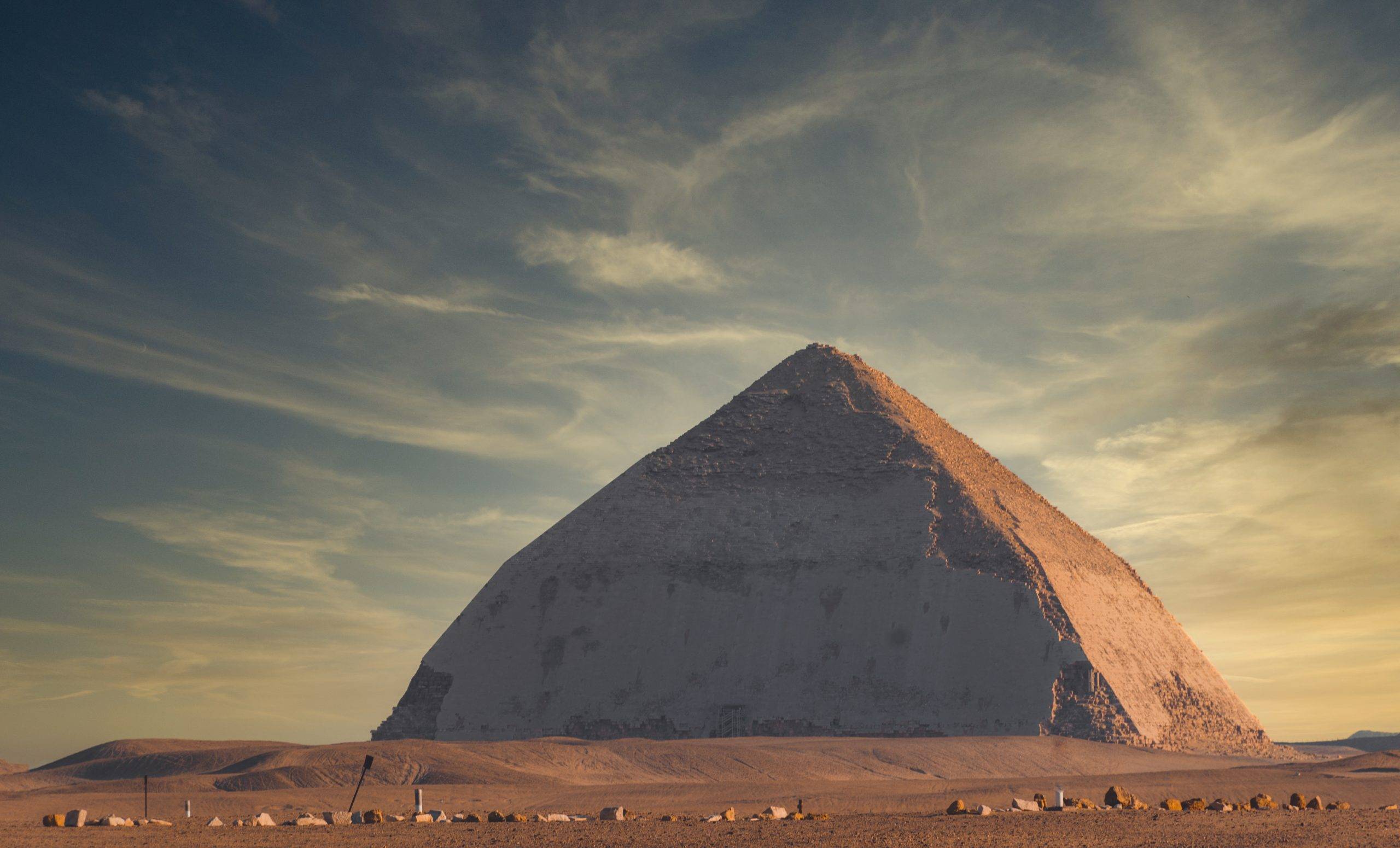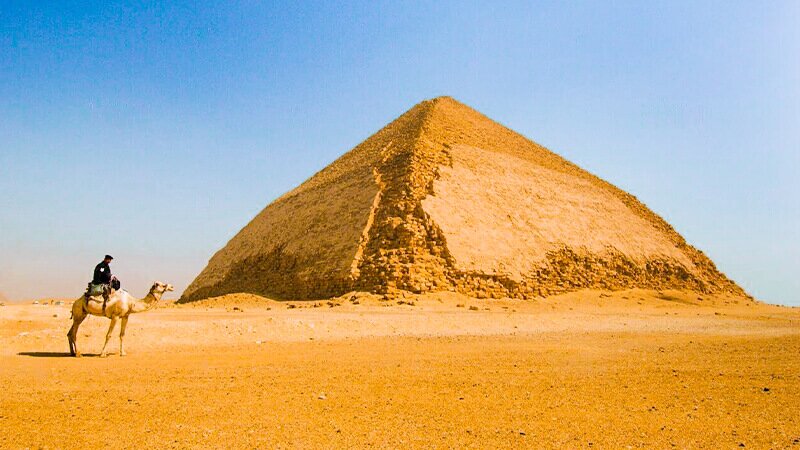Tucked away in the open desert of Dahshur, about 40 kilometers south of Cairo, stands one of Egypt’s most peculiar and captivating monuments — the Bent Pyramid. Unlike the towering giants of Giza, this ancient pyramid stands out not for its size, but for its distinctive, almost awkward, change in angle. It’s a structure that looks as if it’s bending under the weight of time — but what seems like a construction mishap is, in fact, one of the most important milestones in the history of pyramid building.
The Bent Pyramid offers more than just a unique silhouette; it is a gateway into the trial-and-error experimentation of ancient Egyptian architecture, revealing the transitional phase between stepped pyramids and the smooth-sided giants that followed. For travelers seeking a path less traveled and a deeper look into ancient innovation, the Bent Pyramid promises an awe-inspiring and intimate experience.
This comprehensive guide takes you through everything you need to know about this enigmatic monument: its unusual design, rich historical context, groundbreaking engineering, spiritual importance, and practical travel advice.
What Is the Bent Pyramid?
Located in the royal necropolis of Dahshur, the Bent Pyramid was commissioned by Pharaoh Sneferu, the founding king of Egypt’s Fourth Dynasty.
Key Facts:
-
Built: Circa 2600 BCE
-
Builder: Pharaoh Sneferu
-
Original Height: 104.7 meters (344 feet)
-
Angle of Inclination: 54° at the base, then abruptly changes to 43° halfway up
-
Location: Dahshur, south of Saqqara and Giza
-
Status: One of the best-preserved pyramids, with much of its original casing intact
At first glance, the pyramid appears to "bend" inward at the midpoint. This distinct double slope has fascinated scholars and tourists alike. But beyond its odd appearance lies a story of experimentation and advancement.
Why Does the Pyramid Bend?
Theories Behind the Change in Angle:
-
Structural Instability: The original steep angle may have placed too much pressure on the base. Midway through construction, architects reduced the slope to prevent collapse.
-
Pragmatic Adjustments: Pharaoh Sneferu may have wanted to ensure completion during his lifetime. The shift in angle could have been a time-saving solution.
-
Architectural Experimentation: The Bent Pyramid could represent a learning phase in the transition from the step pyramid to a true smooth-sided pyramid.
Sneferu: Egypt’s Master Builder
Pharaoh Sneferu (reigned c. 2613–2589 BCE) is credited with revolutionizing pyramid construction. His reign laid the architectural foundation for the grandeur seen later in the pyramids of Giza.
Sneferu’s Projects:
-
Meidum Pyramid: Initially a step pyramid; collapsed partially
-
Bent Pyramid: Transitional design
-
Red Pyramid: First true smooth-sided pyramid in Egypt
Sneferu’s legacy is that of a visionary ruler whose ambitions directly influenced the golden age of pyramid construction.
His innovations not only changed how pyramids were built but also shaped the cultural and spiritual symbolism surrounding these monuments. The sheer scale and complexity of his projects reflect an organized, highly skilled society with far-reaching logistical capabilities. Each structure he commissioned played a vital role in the evolution of ancient Egyptian funerary architecture.
Design and Engineering
Notable Architectural Features:
-
Double Inclination: A sudden change from 54° to 43° halfway up
-
Two Entrances: One on the north face, another on the western side
-
Internal Chambers: Unusually two chambers not directly connected
-
Casing Stones: Some of the original polished limestone still clings to the surface
The internal layout and double-sloped design demonstrate not just experimentation, but also a deepening understanding of weight distribution and structural integrity.
The builders likely used copper tools, sledges, and wooden rollers, along with manpower and ingenuity to move massive limestone blocks. Stone was quarried nearby, and it’s believed that a network of canals helped transport building materials.
Inside the Bent Pyramid
Visitors can now enter the pyramid, descending through steep and narrow passageways. The air inside is cool and still.
Interior Highlights:
-
First Chamber: Corbelled ceiling, accessed via northern entrance
-
Second Chamber: Higher chamber accessible via western passage
-
Acoustics: Sound behaves strangely inside, enhancing the atmosphere
Exploring inside feels like time travel into the engineering mindset of 4,500 years ago. Some experts believe the dual chambers may have held symbolic meaning, possibly reflecting the duality of life and death or the journey of the soul through the underworld.
Today, metal stairways, wooden railings, and dim electric lighting make the pyramid’s interior accessible to tourists, though it still requires some physical effort to navigate the steep descent and climb.
Myths and Symbolism
In ancient Egyptian thought, pyramids were more than royal tombs. They were spiritual engines designed to help the pharaoh ascend to the heavens.
-
Bent Shape: Some believe the two angles represent dual realms — earth and sky
-
Orientation: The pyramid is precisely aligned to the cardinal points
-
White Casing: Symbolized purity and the sun god Ra’s radiance
The Bent Pyramid may also reflect theological developments in how the afterlife was conceptualized during Sneferu’s reign. Some archaeologists speculate that the change in angle was a deliberate reflection of the pharaoh’s journey — imperfect yet striving toward perfection.
Daily Life During the Bent Pyramid’s Construction
Thousands of workers contributed to the pyramid’s construction. Contrary to popular myth, they were not slaves but skilled laborers who lived in nearby workers’ villages.
Labor Force:
-
Well-fed and housed
-
Rotational work crews
-
Specialists: Masons, architects, surveyors, loggers, boatmen
These workers formed a bustling community, supported by agriculture, bakeries, and breweries. Discoveries of graffiti left by workers inside pyramid blocks further humanize the builders and offer insights into their lives.
Legacy and Influence
The Bent Pyramid stands as a physical record of learning and adaptation. It set the stage for the Red Pyramid, which is considered Egypt’s first successful attempt at a true pyramid and a precursor to the Great Pyramid of Giza.
By studying the Bent Pyramid, modern architects and historians gain an understanding of how ancient Egyptians refined their techniques, embraced risk, and learned from their mistakes.
It also shows us the philosophical ideals of ancient Egypt — symmetry, duality, and divine order — not just as abstract beliefs, but as principles carved into stone.
The Red Pyramid: Sister Monument
Just 2 km north of the Bent Pyramid stands the Red Pyramid, also built by Sneferu.
| Feature | Bent Pyramid | Red Pyramid |
|---|---|---|
| Height | 104.7 m | 105 m |
| Angle | 54° then 43° | 43° uniform |
| Casing | Mostly intact | Mostly lost |
| Shape | Unique bend | True pyramid |
| Access | Open to visitors | Open to visitors |
Together, these two monuments offer a complete narrative arc of pyramid evolution.
Visiting the Bent Pyramid
Getting There:
-
Location: Dahshur, 90 minutes from central Cairo
-
Transport: Private car, tour, or ride-hailing app
-
Nearby Sites: Red Pyramid, Black Pyramid, Saqqara, Memphis
Best Time to Visit:
-
October to April: Pleasant weather
-
Early Morning or Sunset: Cooler temperatures and dramatic lighting
Entrance Fees (Approximate):
-
General Admission: 100–200 EGP
-
Entry into Pyramid: Included or separate depending on ticket
Tips:
-
Wear sturdy shoes
-
Bring water and a flashlight
-
Hire a guide for deeper context
-
Visit during weekdays to avoid crowds
-
Combine with nearby Saqqara and Memphis for a full day trip
Beyond the Bend: Nearby Attractions
1. Red Pyramid
-
Largest pyramid in Dahshur
-
First true smooth-sided pyramid
-
Visitors can enter and explore its chambers
2. Black Pyramid
-
Built by Amenemhat III
-
Mudbrick structure, partially collapsed
-
Not open to the public but viewable from the road
3. Saqqara
-
Home of the Step Pyramid of Djoser
-
Rich with tombs, temples, and mastabas
4. Memphis
-
Ancient capital
-
Outdoor museum with colossal statue of Ramses II
5. Grand Egyptian Museum (Upcoming)
-
Will house the full King Tut collection
-
Modern, state-of-the-art exhibits
-
Great introduction before or after visiting pyramid sites
Where to Stay and Eat
Accommodation:
-
Cairo-based hotels
-
Giza Pyramids area resorts
-
Luxurious options: Marriott Mena House, Four Seasons Cairo
-
Budget options: Zayed Hotel, Pyramids View Inn
Food:
-
Eat before arriving (few options on-site)
-
Nearby local restaurants in Saqqara or Giza
-
Try traditional dishes like koshari, falafel, and grilled meats
Quotes from Historians and Travelers
“The Bent Pyramid is Egypt’s most human monument. You can see the learning curve written into the stone.” — Egyptologist Dr. Salima Ikram
“I had the whole site to myself. It was like touching time.” — Recent visitor, TripAdvisor
"The solitude here is sacred. It’s like Egypt is whispering secrets only a few take the time to hear." — Blogger, NileNotes
Final Thoughts: The Beauty of Imperfection
The Bent Pyramid is not just a quirky structure; it’s a turning point in history. It marks the moment ancient Egypt transitioned from experimental architecture to lasting perfection.
It shows us that even in ancient times, progress required failure, learning, and adaptation. For tourists, it offers solitude, authenticity, and wonder. It’s where ancient ambition is still visible in every miscalculated angle and weathered stone.
Visiting the Bent Pyramid is not only about admiring a monument but also about appreciating the spirit of innovation, humility, and resilience etched into its form.

